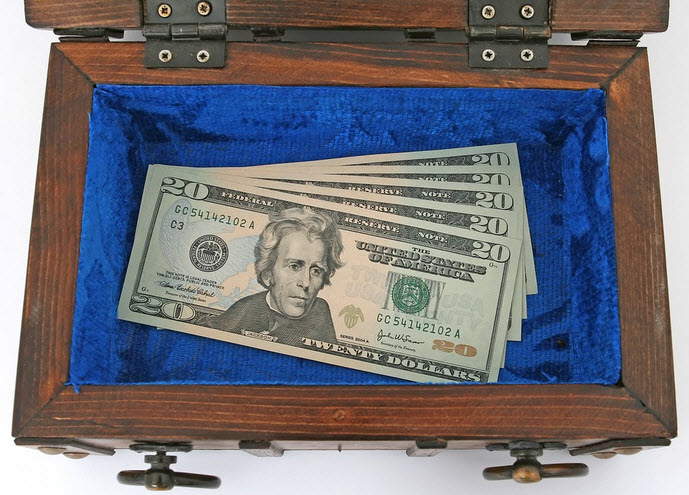
In the first step to saving a million dollars, I’ve provided insights with regard to maximizing your potential to generate income from your employment. The second step was a little dry (I must admit, not a lot of people like to talk about debt), where I advised my readers to avoid costly loans that can potentially destroy one’s savings. If you’ve missed those posts, I’d definitely recommend a quick review before continuing with this post as it’ll help you get more of out this topic. For the third step and beyond, in my opinion, this is where the real fun of saving money starts and the satisfaction is achieved. So let’s get started, plant the seed for our million dollars savings and let it grow. (Sometimes, money does grow on trees, but that’s a topic for another day.)

What are the main factors that affect your money’s growth?
Two of the simplest and widely known factors to growing your money are time and compounding. While most people know these two factors, being able to fully harness the effect of these two factors require another two additional factors: discipline and mindset. Knowing what to do is just half of the battle. Being able to execute according to your saving plan will determine if you are able to reach those planned saving goals or not. Having the discipline and the mindset to keep yourself on-track will significantly increase your chances to reach your saving goals (in my 2016 year-end performance review post, I’ve documented my saving goals for 2017).
| Year | Year Deposit | Year Interest | Total Deposits | Total Interests | Year End Balance |
|---|---|---|---|---|---|
| 1 | $4,080 | $169.61 | $4,080 | $169.61 | $4,249.61 |
| 2 | $4,080 | $499.52 | $8,160 | $669.13 | $8,829.13 |
| 3 | $4,080 | $855.04 | $12,240 | $1,524.16 | $13,764.16 |
| 4 | $4,080 | $1,238.16 | $16,320 | $2,762.32 | $19,082.32 |
| 5 | $4,080 | $1,651.02 | $20,400 | $4,413.34 | $24,813.34 |
| 6 | $4,080 | $2,095.93 | $24,480 | $6,509.27 | $30,989.27 |
| 7 | $4,080 | $2,575.39 | $28,560 | $9,084.65 | $37,644.65 |
| 8 | $4,080 | $3,092.06 | $32,640 | $12,176.71 | $44,816.71 |
| 9 | $4,080 | $3,648.85 | $36,720 | $15,825.56 | $52,545.56 |
| 10 | $4,080 | $4,248.86 | $40,800 | $20,074.42 | $60,874.42 |
| 11 | $4,080 | $4,895.45 | $44,880 | $24,969.87 | $69,849.87 |
| 12 | $4,080 | $5,592.24 | $48,960 | $30,562.10 | $79,522.10 |
| 13 | $4,080 | $6,343.12 | $53,040 | $36,905.22 | $89,945.22 |
| 14 | $4,080 | $7,152.29 | $57,120 | $44,057.51 | $101,177.51 |
| 15 | $4,080 | $8,024.28 | $61,200 | $52,081.79 | $113,281.79 |
| 16 | $4,080 | $8,963.97 | $65,280 | $61,045.76 | $126,325.76 |
| 17 | $4,080 | $9,976.61 | $69,360 | $71,022.36 | $140,382.36 |
| 18 | $4,080 | $11,067.86 | $73,440 | $82,090.22 | $155,530.22 |
| 19 | $4,080 | $12,243.82 | $77,520 | $94,334.04 | $171,854.04 |
| 20 | $4,080 | $13,511.08 | $81,600 | $107,845.12 | $189,445.12 |
| 21 | $4,080 | $14,876.73 | $85,680 | $122,721.85 | $208,401.85 |
| 22 | $4,080 | $16,348.39 | $89,760 | $139,070.24 | $228,830.24 |
| 23 | $4,080 | $17,934.29 | $93,840 | $157,004.53 | $250,844.53 |
| 24 | $4,080 | $19,643.32 | $97,920 | $176,647.85 | $274,567.85 |
| 25 | $4,080 | $21,485.02 | $102,000 | $198,132.88 | $300,132.88 |
| 26 | $4,080 | $23,469.70 | $106,080 | $221,602.58 | $327,682.58 |
| 27 | $4,080 | $25,608.46 | $110,160 | $247,211.04 | $357,371.04 |
| 28 | $4,080 | $27,913.25 | $114,240 | $275,124.29 | $389,364.29 |
| 29 | $4,080 | $30,396.97 | $118,320 | $305,521.26 | $423,841.26 |
| 30 | $4,080 | $33,073.51 | $122,400 | $338,594.77 | $460,994.77 |
| 31 | $4,080 | $35,957.83 | $126,480 | $374,552.60 | $501,032.60 |
| 32 | $4,080 | $39,066.07 | $130,560 | $413,618.67 | $544,178.67 |
| 33 | $4,080 | $42,415.61 | $134,640 | $456,034.28 | $590,674.28 |
| 34 | $4,080 | $46,025.19 | $138,720 | $502,059.47 | $640,779.47 |
| 35 | $4,080 | $49,914.98 | $142,800 | $551,974.45 | $694,774.45 |
| 36 | $4,080 | $54,106.75 | $146,880 | $606,081.21 | $752,961.21 |
| 37 | $4,080 | $58,623.94 | $150,960 | $664,705.15 | $815,665.15 |
| 38 | $4,080 | $63,491.81 | $155,040 | $728,196.96 | $883,236.96 |
| 39 | $4,080 | $68,737.59 | $159,120 | $796,934.55 | $956,054.55 |
| 40 | $4,080 | $74,390.61 | $163,200 | $871,325.16 | $1,034,525.16 |
Data Source: Courtesy of The Calculator Site
Time To Grow Your Money
When it comes to growing your money, time is no doubt one of the most important factors that you can use to work for you. For example, if you start saving your money at the age of 25 with a monthly amount of $340 (annual amount of $4,080 = [$340 * 12]) and earn an annual rate of return of 7.5%, you will have about $1,034,525.16 when you retire at the age of 65. On the other hand, if you started saving just 5 years later, at the age of 30, and everything stays the same, you will have about $694,774.45 at the age of 65. By starting to invest just 5 years earlier with an extra $20,400 = ($4,080 * 5), you’ll end up with an additional $339,750.71 =($1,034,525.16 – $694,774.45) when you retire. That’s an awesome 48.90% (=[$1,034,525.16 – $694,774.45]/$694,774.45) more money. So, when I see how much more money I can save, it actually feels rewarding and satisfying to see my money grows as time goes by. With this example, it’s important to keep your saving in a tax-sheltered account and you can choose either the Tax Free Savings Account (TFSA) or the Registered Retirement Savings Plan(RRSP) account.
| Year | Year Deposit | Year Interest | Total Deposits | Total Interest | Year End Balance |
|---|---|---|---|---|---|
| 1 | $7,020 | $291.83 | $7,020 | $291.83 | $7,311.83 |
| 2 | $7,020 | $859.46 | $14,040 | $1,151.29 | $15,191.29 |
| 3 | $7,020 | $1,471.17 | $21,060 | $2,622.45 | $23,682.45 |
| 4 | $7,020 | $2,130.36 | $28,080 | $4,752.81 | $32,832.81 |
| 5 | $7,020 | $2,840.72 | $35,100 | $7,593.53 | $42,693.53 |
| 6 | $7,020 | $3,606.24 | $42,120 | $11,199.77 | $53,319.77 |
| 7 | $7,020 | $4,431.18 | $49,140 | $15,630.95 | $64,770.95 |
| 8 | $7,020 | $5,320.16 | $56,160 | $20,951.11 | $77,111.11 |
| 9 | $7,020 | $6,278.16 | $63,180 | $27,229.27 | $90,409.27 |
| 10 | $7,020 | $7,310.53 | $70,200 | $34,539.81 | $104,739.81 |
| 11 | $7,020 | $8,423.05 | $77,220 | $42,962.86 | $120,182.86 |
| 12 | $7,020 | $9,621.93 | $84,240 | $52,584.79 | $136,824.79 |
| 13 | $7,020 | $10,913.89 | $91,260 | $63,498.68 | $154,758.68 |
| 14 | $7,020 | $12,306.15 | $98,280 | $75,804.83 | $174,084.83 |
| 15 | $7,020 | $13,806.48 | $105,300 | $89,611.31 | $194,911.31 |
| 16 | $7,020 | $15,423.30 | $112,320 | $105,034.61 | $217,354.61 |
| 17 | $7,020 | $17,165.63 | $119,340 | $122,200.24 | $241,540.24 |
| 18 | $7,020 | $19,043.22 | $126,360 | $141,243.46 | $267,603.46 |
| 19 | $7,020 | $21,066.58 | $133,380 | $162,310.04 | $295,690.04 |
| 20 | $7,020 | $23,247.01 | $140,400 | $185,557.05 | $325,957.05 |
| 21 | $7,020 | $25,596.72 | $147,420 | $211,153.77 | $358,573.77 |
| 22 | $7,020 | $28,128.84 | $154,440 | $239,282.61 | $393,722.61 |
| 23 | $7,020 | $30,857.54 | $161,460 | $270,140.15 | $431,600.15 |
| 24 | $7,020 | $33,798.07 | $168,480 | $303,938.21 | $472,418.21 |
| 25 | $7,020 | $36,966.88 | $175,500 | $340,905.10 | $516,405.10 |
| 26 | $7,020 | $40,381.70 | $182,520 | $381,286.79 | $563,806.79 |
| 27 | $7,020 | $44,061.61 | $189,540 | $425,348.40 | $614,888.40 |
| 28 | $7,020 | $48,027.21 | $196,560 | $473,375.61 | $669,935.61 |
| 29 | $7,020 | $52,300.67 | $203,580 | $525,676.28 | $729,256.28 |
| 30 | $7,020 | $56,905.89 | $210,600 | $582,582.17 | $793,182.17 |
| 31 | $7,020 | $61,868.62 | $217,620 | $644,450.79 | $862,070.79 |
| 32 | $7,020 | $67,216.62 | $224,640 | $711,667.41 | $936,307.41 |
| 33 | $7,020 | $72,979.80 | $231,660 | $784,647.22 | $1,016,307.22 |
| 34 | $7,020 | $79,190.40 | $238,680 | $863,837.61 | $1,102,517.61 |
| 35 | $7,020 | $85,883.13 | $245,700 | $949,720.75 | $1,195,420.75 |
| 36 | $7,020 | $93,095.45 | $252,720 | $1,042,816.19 | $1,295,536.19 |
| 37 | $7,020 | $100,867.67 | $259,740 | $1,143,683.86 | $1,403,423.86 |
| 38 | $7,020 | $109,243.27 | $266,760 | $1,252,927.13 | $1,519,687.13 |
| 39 | $7,020 | $118,269.09 | $273,780 | $1,371,196.22 | $1,644,976.22 |
| 40 | $7,020 | $127,995.61 | $280,800 | $1,499,191.82 | $1,779,991.82 |
Data Source: Courtesy of The Calculator Site
Compound Your Savings
When people talk about compounding the return on your savings, they usually mean that you use the money that you have earned to earn even more money. For example, if you have $5,000 in savings and earned a return of 5% a year, it means that by the end of the first year, you will have a total of $5,250 ($250 earned). For the end of the second year, you will earn $262.50 ($250 from your original $5,000 and $12.50 from your $250 earning after the first year) for a grand total of $5,512.50. As time goes by, the money that you earned, will work hard to earn more money for you. This is the traditional way to grow your money and it’s perfectly fine. However, I like to use a little steroid to compound the growth of my savings (in sports, it’s mostly illegal, but in my savings plan, it’s 100% legal). In one of my previous posts, how I earned a 72% return on my savings, I’ve documented three simple ways that I used to juice up my savings. Let’s assume that I started with the same $340 per month and I get an extra 72% free money, which is the equivalent of $585 (= $340 + 0.72 * $340) per month and $7,020 (= 12 * $585) per year. Just by taking advantage of free money from my employer, government grants, tax refunds and direct everything to my tax-sheltered accounts, I’ll have about $1,779.991.82 by the time that I reach the age of 65 (see the above table). Right now, I am 38 (which means that I am in between year 13 and 14 on the above table) and my saving is a few years ahead ($270,000) at somewhere between year 18 and 19 on the table.

Being A Disciplined Saver
When I first joined the workforce after graduation, I had quite a bit of debt ($30,000 to be exact), my salary was a meager $35,000 per year and I was living away from home. At that time, saving wasn’t a high priority as I was in a very low tax bracket and I did not see the benefit of compounding growth. However, I found a better paying job with a significant increased in my annual income and a great employer matching program when I saved my money. That was a lightbulb moment for me and I realized the snowball effect of my savings. The free money was too tempting and I couldn’t resist. As a result, I set up an automatic savings plan to instantly contribute 6% of my pay to my RRSP account for every pay cheque. The 3% employer matching was directed to the RRSP account too. My year-end bonus of about 8%, directed to my RRSP account. The tax refund of about 8%, also directed to my RRSP account or TFSA. All these free money had turned me into a disciplined money saving machine (if you would like to read more, here’s my poetic way to document how I love saving money). Till this day, I had never withdrawn a single penny from either my TFSA or RRSP account.

The Money Saving Mindset
In today’s consumption-oriented world, our society is constantly bombarded and conditioned by retailers and lenders to spend now, get the impulse satisfaction and leave the saving till tomorrow (how many buy now, save X% and don’t pay till one year later ads have you seen lately?). Over a long period of time, the debt burden will eventually catch up to the consumers, which will result in the consumers working to service their debts and sacrifice their savings. The worse part of all is that those consumers never got into the habit of saving and developed the money-saving mindset. On the other hand, savers have a very disciplined money-saving mindset and savings are habits. They save their money now, get their motivation from reaching towards financial freedom and spend their money tomorrow. One of the easiest examples to develop one’s money-saving mindset and habits can be found by just following one of the tables above. If you save regularly, over a long period of time and let the compounding magic does it work, I can guarantee you that you’ll not only end up with a large pile of savings, you’ll also develop a disciplined money-saving mindset too. You may not be filthy rich, but you will be living quite comfortably, have fewer money worries and will be sleeping soundly at night (just don’t hide money under your mattress, though).

If you like this post, feel free to share and Pin it to Pinterest.
My Two Cents
When it comes to growing your savings, knowing the time and compounding factors is not enough. One has to have the discipline to commit to a savings plan and develop the money-saving mindset and habits to keep the saving plan on-track. Once your saving habit becomes second nature, the true power of time and compounding will work it’s magic and your money will multiply itself.
In The Fourth Step To Saving A Million Dollars, I’ll provide insights on how to grow your savings using the financial market.



 About Leo
About Leo
I keep my money in mutual funds… it seems ok for now… but then again I have just a little money, so I can’t quite see the difference that much
Every little contribution counts Miera. Just keep working on it and your money will grow overtime. You are on the right track by keeping your money in a mutual fund when you first started. However, I think that some mutual funds have very high management fees, so make sure that you are putting your money in an index mutual fund that has a management expense ratio (MER) of less than 0.5%. The lower the MER the better. Otherwise, you are paying too much.
The fact that you started is half the battle. When I started with mutual funds in the mid 90’s it was in the middle of the recession. Money was going nowhere (like what you are experiencing) but I was dollar cost averaging.
I was even complaining to my mentor that I was wasting my time, and he replied “you disappoint me, stick to your goals” then one day BOOM, my money went up exponentially. It was shocking. Then the Tech boom came and went.
Be smart, have a plan and keep invested depending on your age. You only lose when you sell. When the market is in turmoil, find whatever cash you can and go in. Even though the last 9 years have been GREAT for me, I wish I had more cash in 2008, because life would’ve been even better.
I couldn’t have said it better Jim. You’ve made a really good point about dollar cost averaging, which is going to be covered in the next step (spoiler alert lol).
I have to completely agree with you on the time factor. Having discipline to commit is good aspect to consider as well, plus having a good mindset also helps to keep everything on track too. Cheers to the tips!
Shivani, I may sound like a broken record, but time is the best factor to grow your money. As I mentioned in the post, by investing 5 years earlier, you get almost 50% more money when you retire. And having more money at that time is definitely good.
Being a disciplined saver is one of the toughest act, I must say, but once you get the groove, you will be surprised at how much you’re able to save!
You are right Cindy. Most of the time, people fail to save not because they don’t have the money or know how. It’s because they don’t have the discipline to stick to their saving plan and the saving mindset. Hopefully, you’ve found your groove and share your money saving tips with us someday.
With a fluctuating income, it is difficult to save. I just pay whatever I need to and the rest goes into saving. I am still searching for the best way for it to compound.
Emily, sometimes when your income is unpredictable and irregular, you’ll be facing an extra challenge comparing to folks who have stable employment. You sound like the discipline saver type and I encourage you to continue on with what you’re doing. FYI, in the fourth step, I will be sharing actual ways to grow your savings. So stay tuned.
In India, we have something called PPF (Public Provident Fund) and it was its compound interest that attracted me to begin my investments with it!
Your comment ringed a bell Bhusha. I think you’ve just added a new factor – motivation. I find that free money and tax refunds are two of the best motivators for me to save.
Saving and time are definitely important as you said. I had a conversation with my boss yesterday over lunch and he thinks I’m going to be better off financially than every single one of our colleagues due to the fact I got into real estate at 22 and have a pretty good job at my age now. I’m looking to keep building wealth through property, be it online with a blog, or more real estate. Time will tell what we can do!
When you start early, you definitely will be better off than the folks that are still partying at the age of 22, Erik. In addition, it sounds like your are increasing the number of income sources and that’s the perfect recipe for growing your wealth. I heard that most high net worth individuals have about 7 sources of income. I am at five income sources now and looking to increase a couple more in the coming years.
The savings rate is such an underrated way of generating wealth. Too often people think that they to make tons of money when in reality it’s that you save more than you make. Over time if you can save enough you can really compound that and reach your goals. Awesome post!!!
You are definitely right MSM. When I first started saving, the saving rate was high, the growth rate was quite slow and I don’t see a lot of visible results. However, a decade later, with a great year, the compounding earned me more that what I make in a year of annual salary at my full time job.
wa the charts are so detailed. With the inflation rate of Ringgit, I would rather spend now than to save haha
Balancing your spending now and saving for later is not an easy act R.C. However, regardless of where inflation is right now, there’s always room for saving. Hopefully you can develop the discipline to save when you have further understanding of what compounding can do for your savings.
Thanks for sharing this with us. It is really useful.
Not a problem Shini. It’s great knowing that my post is useful to you. Thank you for sharing your thought.
It’s a very interesting read. I guess motivation still play a big role tho, at least for me
Finding your motivation to save is not that difficult Carina. For me, the motivation comes from reaching my early retirement at the age of 48. You can definitely find your motivation and use that to keep your saving on-track. It takes a bit of time, but with a little discipline, you can do it.
Like Leo said…the easiest motivation is financial independence. I was making $720 a month, trying to get out of $2K of debt first. A financial counselor advised to track every expense down to the penny for two months. This was in the early 90’s as a 22 yr old. When that was paid off I remember it well. I could have spent more money on things a young 23 yr old or resist the urge. Thankfully back then savings accounts made 7% interest, and CD’s even more. I was proud of what I had saved over a short period of time until I met a roommate who told me about mutual funds. At 24, I went to the library (before the Internet) and took out the 3 easiest to read books and discovered they all basically said the same thing. I found a good performing fund (over 5-10 yr performance) with a low initial investment and dollar cost averaged into it.
Whatever found money would go into the fund.
As I posted above, the first few years, my investments went nowhere. I was disappointed but honestly didn’t even know what a recession was at the time. Then one day BAM, my fund went up exponentially!! I was shocked. All those months of DCA allowed me to accrue a large # of shares.
During the tech boom, on any given day I’d make more in the market then I would 2 or 3 months of salary busting my hump. It was then I visualized Financial Independence, that I could possibly retire at 40. But of course, it never lasts and the market busted in 2000. Thankfully didn’t sell and kept the shares invested. I was laid off in 2002 and it was then that I realized didn’t want to work the rest of my life.
Continued to throw raises and found money to the market. The bust of 2008 came and went and in 2016, the company I had worked for 14 yrs closed its doors. I was losing my job but I would make more money in Unrealized Capital Gains distributions at year end then I would in a salary. Very frustrating.
But this time, like Leo, I can actually retire at 47. I had hoped to make it another 7-8 yrs with the company simply to pad my investments but the ship sank beforehand. Still unemployed 6 months later, the last 3 months the market has gone up enough to pay for 3 years of retirement.
If I had any words of advice to youngsters, stay ahead of debt. You either make Interest, or spend on Interest.
What an inspiring story Jim. You’ve shown the true meaning of buy and hold and ignore the day to day non-sense of the market. I think the advice give are for all investors in general and I can also use that advice myself. Thank you for sharing Jim.
WOW, I’m glad I found your blog. Saving and investing money they are priorities for me. I am willing to find out something more and for sure I will come back for more posts. Good luck with rhubarb 🙂
@Ewa, I am glad that my blog is useful to you and hopefully, the concepts that I shared will benefit you and help you build a secure and sound financial future. And yes, I am trying to plant rhubarb in my garden this summer. Gardening have become a peaceful and enjoyable past time for me. Not to mention, it’s also saving me money :).
emm …. time To Grow my Money…
Yes, the time is now Siawsiawlife. The earlier you start, the better. Try to find your purpose and motivation. I find it to be very helpful to keep me on track.
I kept mine for savings, mutual funds and real estate investments. They are doing fine so far 🙂
Great job of spreading your money around and diversifying. Just remember that the mutual fund should be low cost. If the management fees are more than 0.5% per year, then you are paying too much fees.
We’re talking serious money! Thanks for the tips shared. Shall keep this in mind.
@Aliza, I am glad that this post resonate with you. Thank you for sharing and dropping by.
Very interesting topic, I enjoy reading it. Thanks for the useful information 🙂
@Ivy, Thank you for the complement. It really motivates me to write more posts to share with others. Thank you for dropping by.
Gotta love compound interest. The 8th wonder of the world. Seeing tables like the ones in your posts early on in my career is what led me to save early and often. It really is simple to accumulate wealth when you think about it. All you need is time and some discipline.
@GFY, I don’t think that using time and compounding to grow your money is new. I strongly believe discipline and mindset is what some people lacked to push them to save now and spend later. For example, most people can save $5,000 in a year, but to be able to save $5,000 year, after year, after year requires discipline.
Another great article, I’m 33 and started reading about finances 5 years ago. Its hard to remember how much money i used to waste 200$ for jordan shoes to look cool etc etc. I made good money when I was 16, if only I invested it then. Ahhhh well can’t go back, the futures looking good. Pay yourself first. congrats on being 6 years ahead of schedule on your timetable too!
@PassiveCanadianIncome, the power of compounding is really amazing once you are able to harness it’s true power. What really amazes me is that once your money grows to a certain amount, your growth will be greatly magnified. This is how I was able to get ahead of by six years of my saving goals.